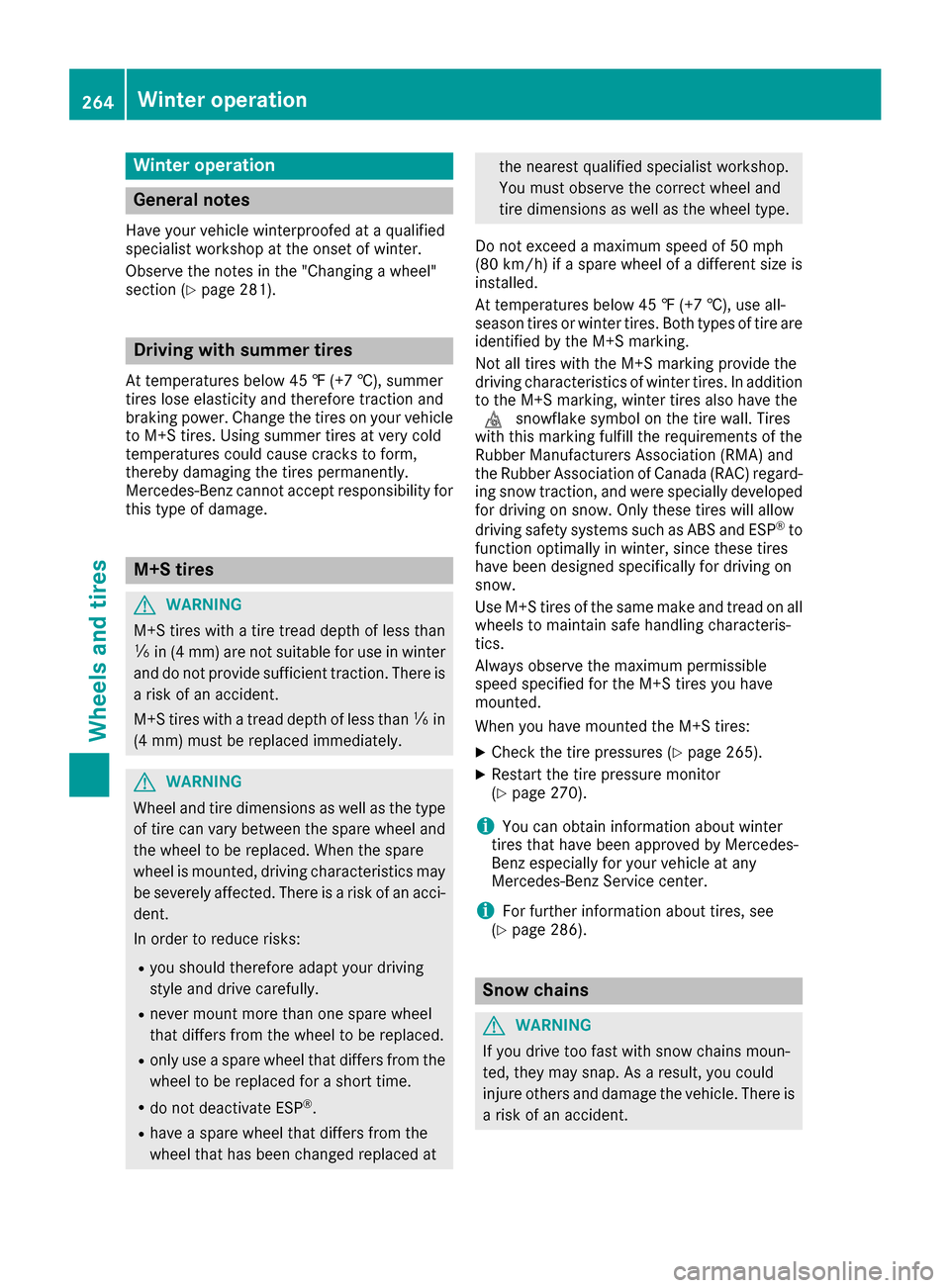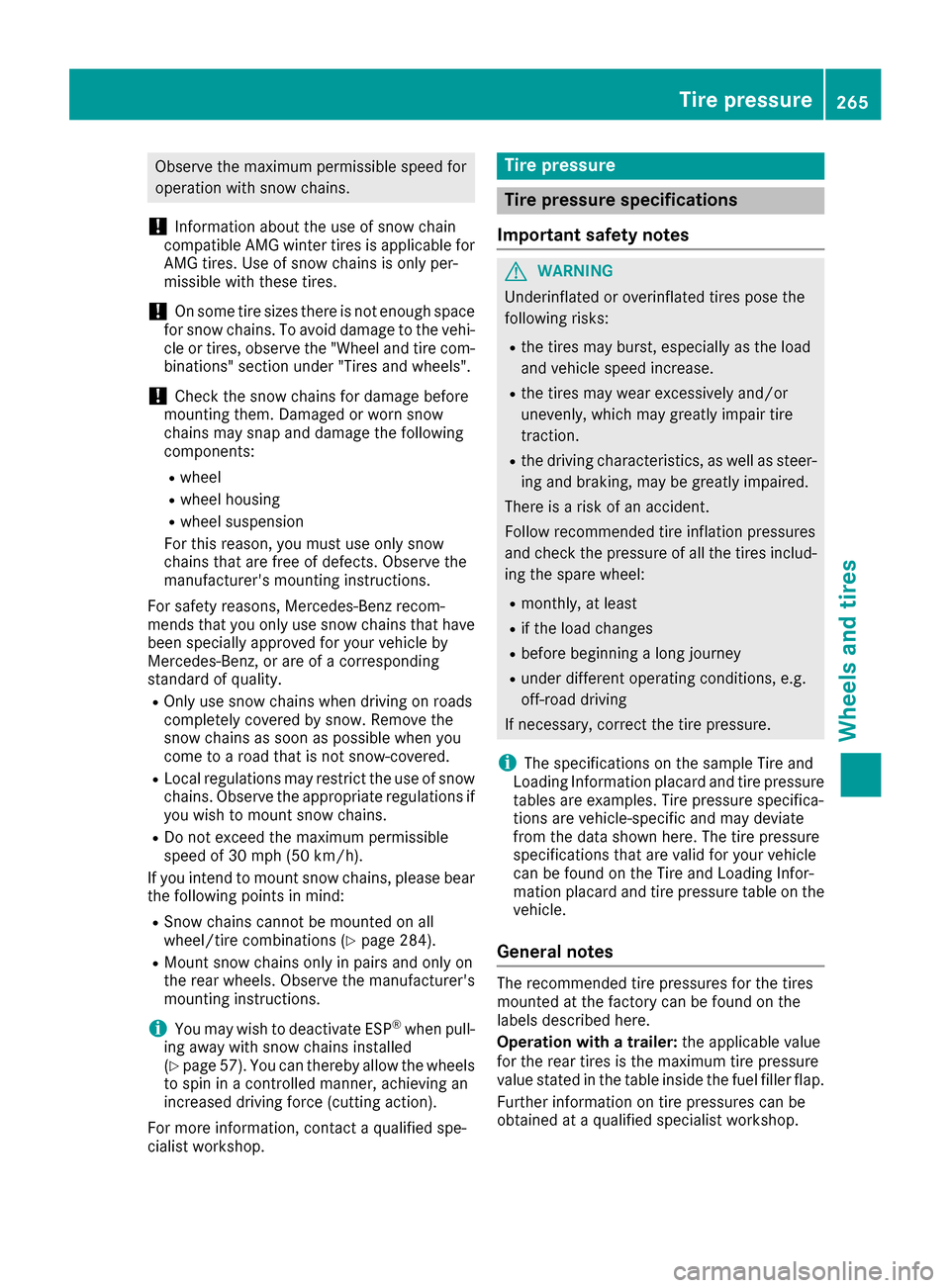Page 266 of 302

Winter operation
General notes
Have your vehicle winterproofed at a qualified
specialist workshop at the onset of winter.
Observe the notes in the "Changing a wheel"
section (
Ypage 281).
Driving with summer tires
At temperatures below 45 ‡ (+7 †), summer
tires lose elasticity and therefore traction and
braking power. Change the tires on your vehicle
to M+S tires. Using summer tires at very cold
temperatures could cause cracks to form,
thereby damaging the tires permanently.
Mercedes-Benz cannot accept responsibility for
this type of damage.
M+S tires
GWARNING
M+S tires with a tire tread depth of less than
ã in (4 mm) are not suitable for use in winter
and do not provide sufficient traction. There is
a risk of an accident.
M+S tires with a tread depth of less than ãin
(4 mm) must be replaced immediately.
GWARNING
Wheel and tire dimensions as well as the type of tire can vary between the spare wheel and
the wheel to be replaced. When the spare
wheel is mounted, driving characteristics may be severely affected. There is a risk of an acci-
dent.
In order to reduce risks:
Ryou should therefore adapt your driving
style and drive carefully.
Rnever mount more than one spare wheel
that differs from the wheel to be replaced.
Ronly use a spare wheel that differs from the
wheel to be replaced for a short time.
Rdo not deactivate ESP®.
Rhave a spare wheel that differs from the
wheel that has been changed replaced at
the nearest qualified specialist workshop.
You must observe the correct wheel and
tire dimensions as well as the wheel type.
Do not exceed a maximum speed of 50 mph
(80 km/h) if a spare wheel of a different size is
installed.
At temperatures below 45 ‡ (+7 †), use all-
season tires or winter tires. Both types of tire are
identified by the M+S marking.
Not all tires with the M+S marking provide the
driving characteristics of winter tires. In addition
to the M+S marking, winter tires also have the
i snowflake symbol on the tire wall. Tires
with this marking fulfill the requirements of the
Rubber Manufacturers Association (RMA) and
the Rubber Association of Canada (RAC) regard-
ing snow traction, and were specially developed
for driving on snow. Only these tires will allow
driving safety systems such as ABS and ESP
®to
function optimally in winter, since these tires
have been designed specifically for driving on
snow.
Use M+S tires of the same make and tread on all
wheels to maintain safe handling characteris-
tics.
Always observe the maximum permissible
speed specified for the M+S tires you have
mounted.
When you have mounted the M+S tires:
XCheck the tire pressures (Ypage 265).
XRestart the tire pressure monitor
(Ypage 270).
iYou can obtain information about winter
tires that have been approved by Mercedes-
Benz especially for your vehicle at any
Mercedes-Benz Service center.
iFor further information about tires, see
(Ypage 286).
Snow chains
GWARNING
If you drive too fast with snow chains moun-
ted, they may snap. As a result, you could
injure others and damage the vehicle. There is
a risk of an accident.
264Winter operation
Wheels and tires
Page 267 of 302

Observe the maximum permissible speed for
operation with snow chains.
!Information about the use of snow chain
compatible AMG winter tires is applicable for
AMG tires. Use of snow chains is only per-
missible with these tires.
!On some tire sizes there is not enough space
for snow chains. To avoid damage to the vehi- cle or tires, observe the "Wheel and tire com-
binations" section under "Tires and wheels".
!Check the snow chains for damage before
mounting them. Damaged or worn snow
chains may snap and damage the following
components:
Rwheel
Rwheel housing
Rwheel suspension
For this reason, you must use only snow
chains that are free of defects. Observe the
manufacturer's mounting instructions.
For safety reasons, Mercedes-Benz recom-
mends that you only use snow chains that have
been specially approved for your vehicle by
Mercedes-Benz, or are of a corresponding
standard of quality.
ROnly use snow chains when driving on roads
completely covered by snow. Remove the
snow chains as soon as possible when you
come to a road that is not snow-covered.
RLocal regulations may restrict the use of snow
chains. Observe the appropriate regulations if
you wish to mount snow chains.
RDo not exceed the maximum permissible
speed of 30 mph (50 km/h).
If you intend to mount snow chains, please bear
the following points in mind:
RSnow chains cannot be mounted on all
wheel/tire combinations (Ypage 284).
RMount snow chains only in pairs and only on
the rear wheels. Observe the manufacturer's
mounting instructions.
iYou may wish to deactivate ESP®when pull-
ing away with snow chains installed
(
Ypage 57). You can thereby allow the wheels
to spin in a controlled manner, achieving an
increased driving force (cutting action).
For more information, contact a qualified spe-
cialist workshop.
Tire pressure
Tire pressure specifications
Important safety notes
GWARNING
Underinflated or overinflated tires pose the
following risks:
Rthe tires may burst, especially as the load
and vehicle speed increase.
Rthe tires may wear excessively and/or
unevenly, which may greatly impair tire
traction.
Rthe driving characteristics, as well as steer-
ing and braking, may be greatly impaired.
There is a risk of an accident.
Follow recommended tire inflation pressures
and check the pressure of all the tires includ-
ing the spare wheel:
Rmonthly, at least
Rif the load changes
Rbefore beginning a long journey
Runder different operating conditions, e.g.
off-road driving
If necessary, correct the tire pressure.
iThe specifications on the sample Tire and
Loading Information placard and tire pressure
tables are examples. Tire pressure specifica-
tions are vehicle-specific and may deviate
from the data shown here. The tire pressure
specifications that are valid for your vehicle
can be found on the Tire and Loading Infor-
mation placard and tire pressure table on the
vehicle.
General notes
The recommended tire pressures for the tires
mounted at the factory can be found on the
labels described here.
Operation with a trailer: the applicable value
for the rear tires is the maximum tire pressure
value stated in the table inside the fuel filler flap.
Further information on tire pressures can be
obtained at a qualified specialist workshop.
Tire pressure265
Wheels and tires
Z
Page 288 of 302

Tires
G 550
All-weather tires
Tires (radial tires)Alloy wheels
265/60 R18 110V M+S7.5J x 18 H2 ET 43
265/60 R18 110 H M+S7.5J x 18 H2 ET 43
275/55 R19 111V M+S59.5J x 19 H2 ET 50
iYou can obtain information about tires and tire dimensions that are not listed here at any
authorized Mercedes-Benz Center.
G 63 AMG
Summer tires
TiresAlloy wheels
275/50 R20 113W XL69.5J x 20 H2 ET 50
iYou can obtain information about tires and tire dimensions that are not listed here at any
authorized Mercedes-Benz Center.
All-weather tires
TiresAlloy wheels
295/40 R21 111W XL M+S610J x 21 ET45
iYou can obtain information about tires and tire dimensions that are not listed here at any
authorized Mercedes-Benz Center.
Winter tires
TiresAlloy wheels
265/55 R19 109H M+S9.5J x 19 H2 ET 50
iYou can obtain information about tires and tire dimensions that are not listed here at any
authorized Mercedes-Benz Center.
Spare wheel
!The spare wheel must be inflated to the maximum tire pressure given in the table on the inside
of the fuel filler flap.
iThe spare wheel corresponds to the standard tires.
5Vehicles with AMG Sports package only.6Use of snow chains not permitted. Observe the notes in the "Snow chains" section.
286Wheel and tire combinations
Wheels and tires